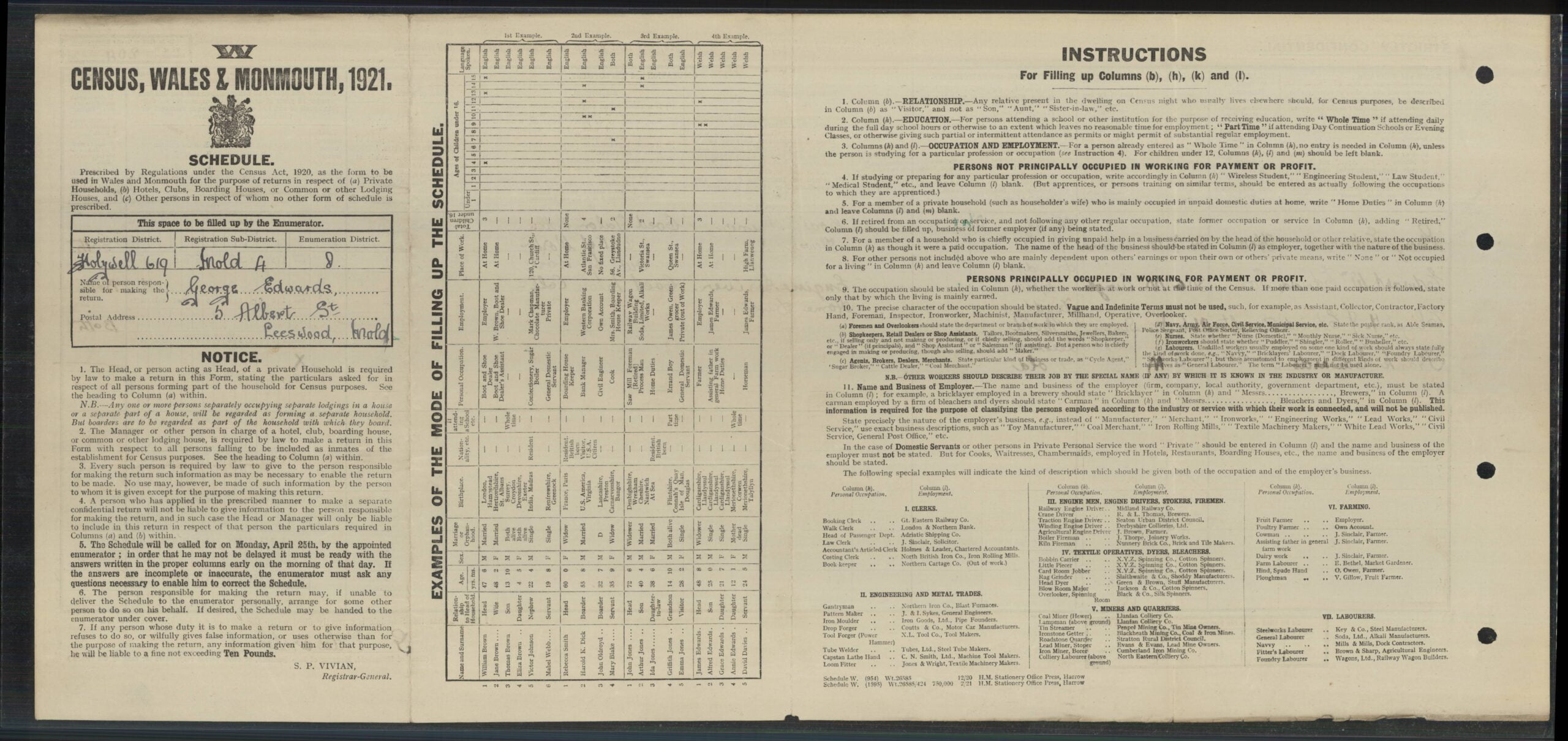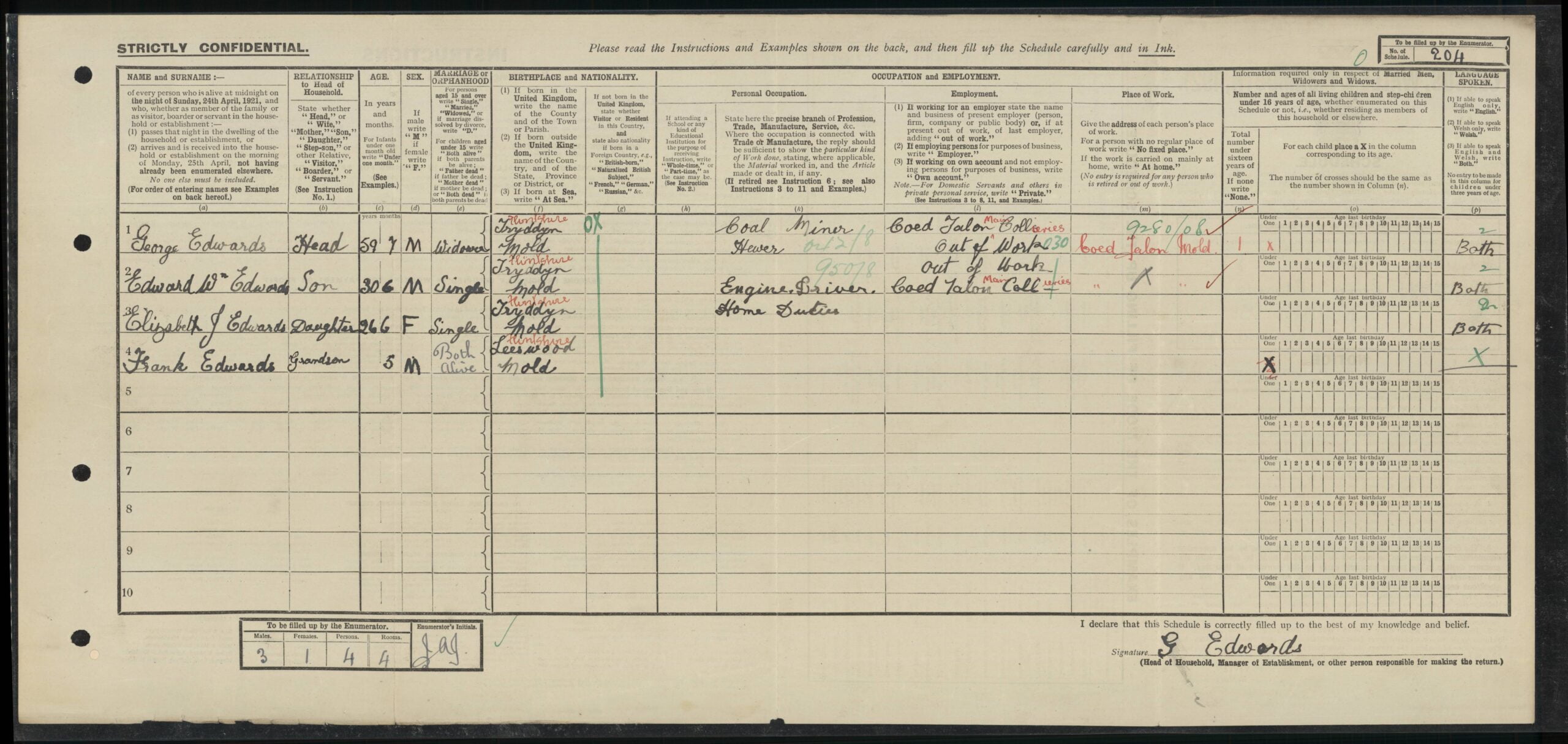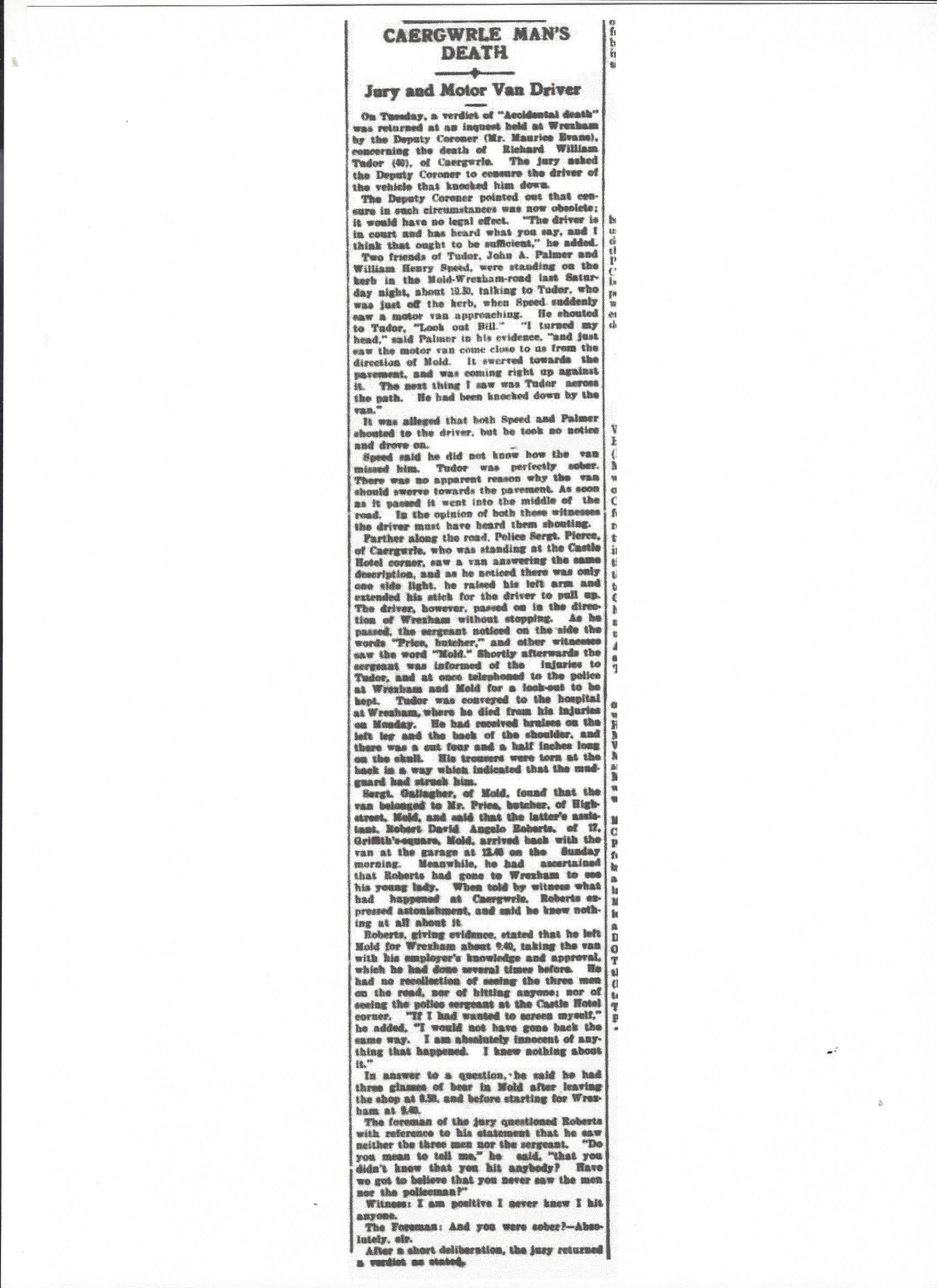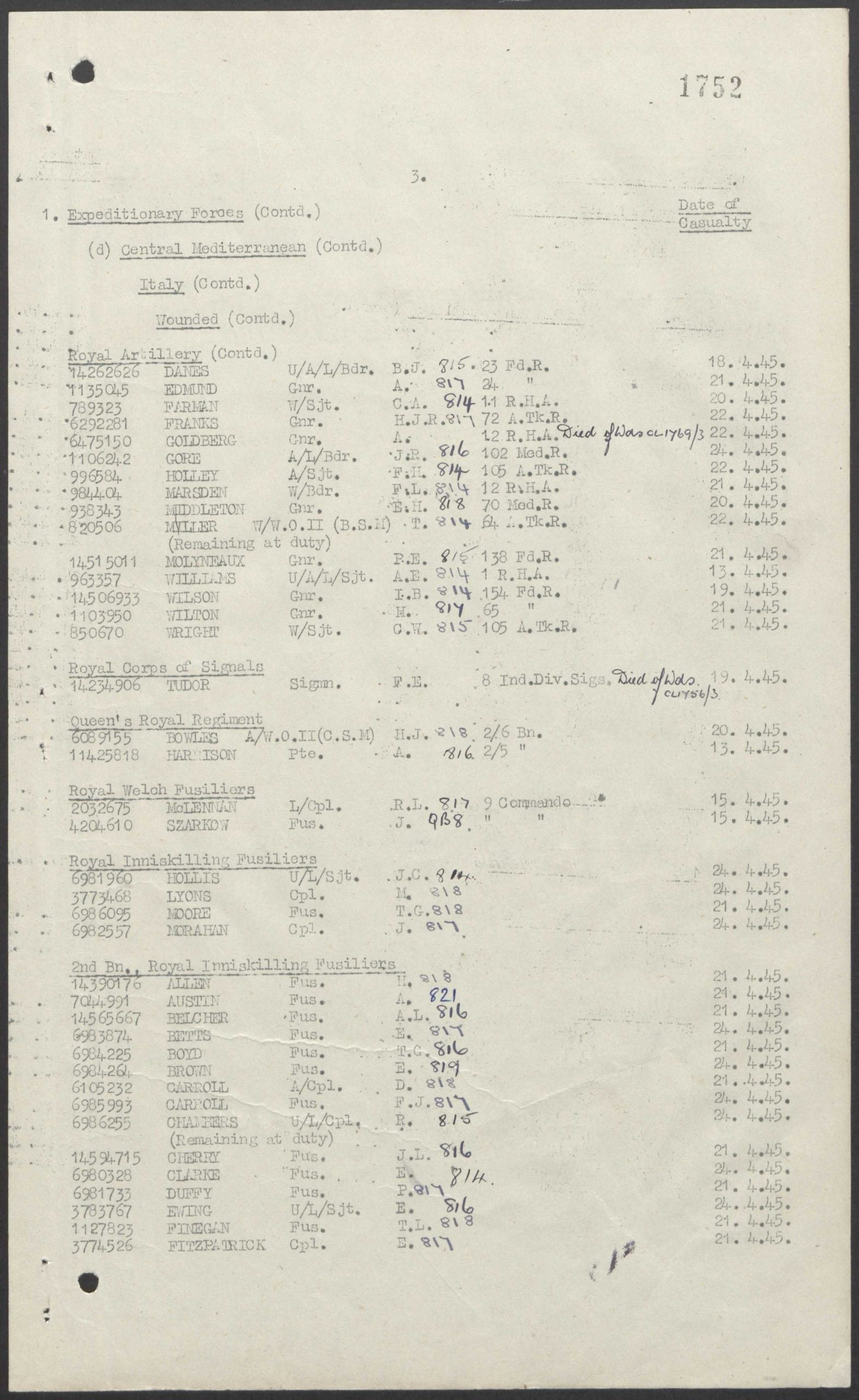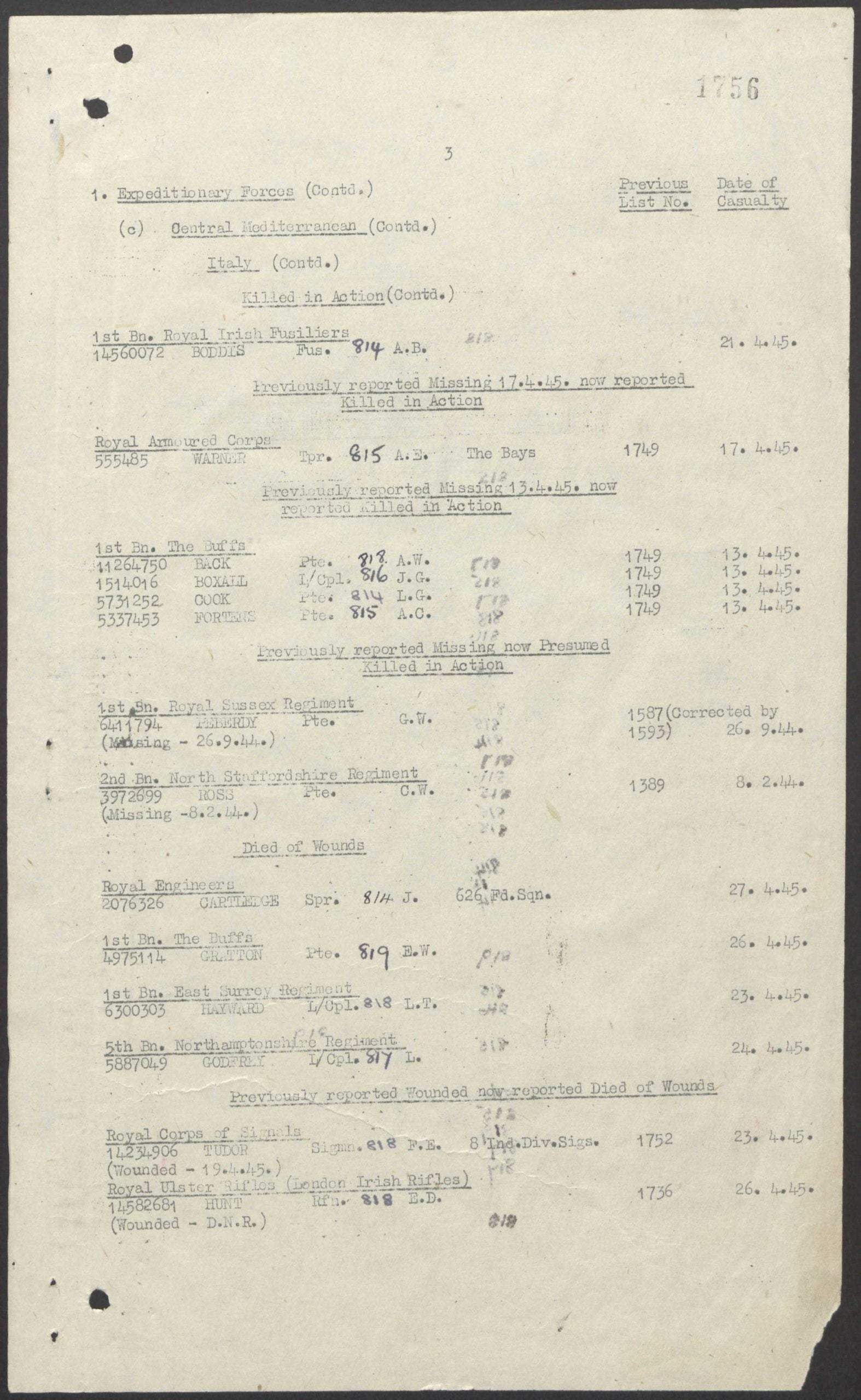According to the Hawarden Grammar School Admissions Register E/GS/1/10, Frank Tudor was born on the 13th of February 1921, he was the son of Richard William & Elizabeth Jane Tudor (nee Edwards) who married in a Civil Marriage in Hawarden. (Flintshire (Mold) HAW/08/54) in the December quarter of 1923.
I found Richard William Tudor living at Top y ffor, Horeb, Hope, Caergwrle, Flintshire, which was taken on the 19th of June 1921. He was living with his grandmother Mary Ellis and sister Florrie Tudor. Mary Ellis was head of the household, 77 years, and 8 months old, born in Prestatyn, Flintshire and a widow and ‘Old Age Pensioner.’ Richard William was 28 years old, single and a Coal Miner at Llay Hall Colliery Coy. But was ‘Out of Work.’ Florrie Tudor was 19 years and 1 month old, single, and doing ‘Home Duties.’ They were both born in Horeb, Flintshire.
Likewise, Elizabeth J. Edwards was living at 5, Albert Street, Leeswood, Mold, Flintshire on the 1921 census, living with her family. Her father George Edwards was head of the family, he was 59 years and 7 months old, a widower and Coal Miner (Hewer) at the Coed Talon Colliery, Mold, but was ‘Out of Work.’ His son Edward Wm. Edwards was 30 years and 6 months old, single and like his father worked at the same Colliery but was an Engine Driver. He too was out of work because of the Miner’s Strike. Elizabeth J. Edwards was 26 years and 6 months old, single and doing ‘Home Duties.’ George Edwards’s Grandson, Frank Edwards, aged 5 months, with both his parents alive, had been born in Leeswood, Mold, Flintshire. The others had all been born in Tryddyn, Mold, Flintshire.
I have no information about Frank Edward’s early years except for his time in Hawarden Grammar School:- 1688/ 2394 TUDOR, Frank . Date of birth – 13th February 1921., Pentre Hse., Pentre Lane, Caergwrle, Father – Miner (Dec.) date of entry 19th September 1933, Former School – Hope Council date of leaving – 22nd July 1936 – Hortec* (sic) School.
*Perhaps Horticultural College?
Sadly, the year before he entered the school, in 1932, his father Richard William Tudor had died in a Road Traffic Accident in Caergwrle, the Hope Parish Registers have the entry of Richard William Tudor’s burial on the 16th of June 1932 age 39 years. Please see the entry and the newspaper reports below.
After Frank Edward Tudor left school, again, I have no knowledge of his teen years, so any information to tell his story would be gratefully received, so he won’t be forgotten.
On the 1939 National Register, which was taken on the 29th of September 1939, we see his mother Elizabeth Jane Tudor, living at 2, Bryn Yorkin, Caergwrle with, I believe, her brother Edward William Edwards. This source gives us the dates of birth, so we see that Elizabeth Jane, a widow, was born on the 30th of December 1894 and she was, as most married or widowed women without a job, was described as doing “Unpaid Domestic Duties.” Edward William Edwards was born on the 23rd of January 1891 and he was a general Labourer in Heavy Work.
Frank Tudor, on the 1939 National Register, was living at the Post Office, High Street, Overton, Flintshire, Wales. Hed is seen in the household of the Sub Postmaster Frank Williams and his wife Hilda and, I believe, 3 children, although the records are redacted or closed. Frank Tudor is the Sub Postmaster’s Assistant, single and was born on the 13th of February 1921.
I do not know the date that Frank Edward Tudor enlisted or was conscripted, as men over 18 was required to do. https://www.parliament.uk/about/living-heritage/transformingsociety/private-lives/yourcountry/overview/conscriptionww2/#:~:text=On%20the%20day%20Britain%20declared,had%20to%20register%20for%20service. – Your Country needs you. – On the day Britain declared war on Germany, 3 September 1939, Parliament immediately passed a more wide-reaching measure. The National Service (Armed Forces) Act imposed conscription on all males aged between 18 and 41 who had to register for service.
I did find the lady he was to marry in 1944 on the 1939 National Register, Dorothy P. Taylor*, born on the 12th of February 1920, was living at Trinity Mill, Cirencester R.D., Gloucestershire, England in the Barker Household, and she is described as single and a Domestic Help, but I don’t know if that was at that household, she was also an A.R.P. Dorothy also is supposed, according to this document, to have married twice** but there is a dispute with the date they gave. It is this source that also gives the clues to her marriages.
*Marriage to Frank on the 27th of November 1944 according to the Register in Folder, that doesn’t gel with the FREE BMD, which give the Quarter of 1944 as September. (Please see below)
** 2nd Marriage to Basil Starling at Cirencester (Vol. 7b Page 897) on the 31st of July 1950 according to the Register in Folder.
So, I am presuming that Frank Edward was stationed in Gloucestershire or the surrounding countryside with the 8 Ind. Div. Sigs. Royal Corps of Signals, as he met and married Dorothy Prudence Taylor in the September quarter of 1944 (Cirencester Vol. 6a Page 1151) – The district Cirencester spans the boundaries of the counties of Wiltshire and Gloucestershire.
He then was posted abroad and perhaps this website may help to find out what happened to Frank Edward Tudor :- https://en.wikipedia.org/wiki/8th_Infantry_Division_(India)
8th Infantry Division (India) – Italy
On 24 September 1943 the 8th Indian Division landed in Taranto, to take its part in the Italian Campaign. The division landed 21 days after the initial invasion, as part of V Corps, commanded by Lieutenant-General Charles Allfrey, serving alongside British 4th Armoured Brigade and the British 78th Infantry Division. For 19 months the division was almost continuously in action, advancing through mountainous country, crossing river after river. The formation later adopted the motto “One more river”.
From October 1943 to April 1944 the 8th Indian Division was part of the Allied thrust by the British Eighth Army, under General Sir Bernard Law Montgomery, up the Adriatic front on the Eastern side of Italy. This involved opposed river crossings of the Biferno, Trigno (October 1943), Sangro (November 1943) and Moro (December 1943). The following three months proved almost as arduous for, although there was no formal offensive, the period was characterised by patrolling and vicious skirmishes in very difficult terrain and abominable winter weather, which proved to be extremely demanding, both physically and mentally, and very stressful.
Cassino
When the spring came the 8th Indian Division was switched in great secrecy (along with the bulk of the British Eighth Army, now commanded by Lieutenant-General Sir Oliver Leese) 60 miles west across the Apennine Mountains to concentrate as part of Lieutenant-General Sidney C. Kirkmans British XIII Corps, serving alongside the British 4th and 78th Infantry Division, 6th Armoured Divisions, as well as the 1st Canadian Armoured Brigade, along the River Garigliano at a part of the river better known as the Gari. Their heavily opposed night crossing of the Gari in May 1944, supported by Canadian tanks (1st Canadian Armoured Brigade) with which the division had formed a particularly close fighting relationship over the previous six months, was critical to the Allies’ success in this, the fourth and final Battle of Monte Cassino. Following this, the division advanced some 240 miles in June across mountainous country, fighting many actions against rearguards and defended strongpoints. In late June they had reached Assisi and the division was rested. It was during the fighting on the Gari that Kamal Ram of the 3rd Battalion, 8th Punjab Regiment was awarded his Victoria Cross. At 19 years of age, he was one of the youngest recipients of the VC during the Second World War.
Florence and the Gothic Line
By the end of July 1944, after a few weeks out of the line, the 8th Indian Division was back in the line with 1st Canadian Armoured Brigade in front of Florence pushing towards the River Arno. Florence was occupied by the 21st Indian Infantry Brigade on 12 August where they had the unusual task to recover some of the world’s greatest art treasures and arrange safe custody. By mid-September the division was in the mountains again, breaking through the Gothic Line and then spending two months of grim (and ultimately unsuccessful) battling in foul weather towards the plains of Northern Italy, together with the British 1st Infantry, 78th Infantry and 6th Armoured Divisions, alongside the 1st Canadian Armoured Brigade, forming British XIII Corps. XIII Corps had now become the right wing of the U.S. Fifth Army, commanded by Lieutenant General Mark W. Clark. It was during this time that Thaman Gurung of the 1st Battalion, 5th Royal Gurkha Rifles was awarded the Victoria Cross.
In December 1944 the 2nd New Zealand Division, advancing from the Adriatic on the division’s right along the Romagna plain, took Faenza and the resistance on the 8th Indian Division’s front weakened as the Germans withdrew to shorten their front. In late December 1944, 19th and 21st Brigades were rapidly switched across the Apennines to reinforce the U.S. 92nd Infantry Division on the Fifth Army’s left flank in front of Lucca. By the time they had arrived the Germans had broken through but decisive action by Major-General Russell halted their advance and the situation was stabilised by the New Year. The 8th Indian Division then moved to Pisa for a period of rest.
Excerpt from the Commonwealth War Graves Commission History information – In the northern Apennine mountains the last of these, the Gothic Line, was breached by the Allies during the Autumn campaign and the front inched forward as far as Ravenna in the Adriatic sector, but with divisions transferred to support the new offensive in France, and the Germans dug in to a number of key defensive positions, the advance stalled as winter set in. The final Allied offensive began early the following April and Argenta Gap War Cemetery marks the final stages of the hard fighting in Italy in the spring of 1945.
Casualty List 1752 (Page 3) give the information that Frank is wounded on the 19th of April 1945 and the Casualty List 1756 (Page 3 tells us that sadly Frank had died of wounds on the 23rd of April.
I presume that he was buried on the day he died or shortly thereafter, but according to the Commonwealth War Graves Commission Concentration Reports Form, he was reburied on the 15th of June 1945 at Argenta Gap Cemetery. (see below)
He was remembered of course by the Hawarden Grammar School, and his name is on the Roll of Honour. The Roll of Honour was dedicated at Hawarden Grammar School on the 3rd of February 1951 with a Remembrance Service for the 47* former pupils who died in the 1939 – 1945 World War. As recorded in the Chester Chronicle Saturday 10th February 1951.
*Author’s note, there are 46 names on the Roll of Honour, clerical error by the newspaper.
Frank Edward was truly loved and missed by his family, and I hope that his mother and other members of his family including his wife Dorothy Prudence were able to attend. The inscription on his headstone tells of a true love story.
“IN LOVING MEMORY OF MY DEAR HUSBAND AND OUR SHORT TIME TOGETHER. DOROTHY”


